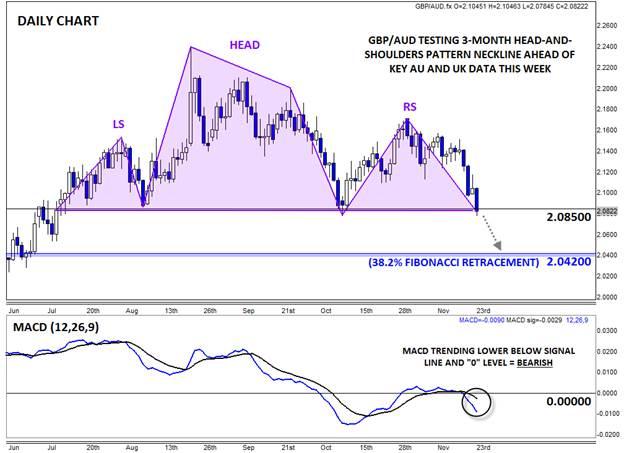![]()
US traders are eagerly counting down the hours until the much-awaited Thanksgiving holiday, but our readers should is still a busy economic calendar between now and Wednesday afternoon, as well as a couple of noteworthy economic releases on Thursday and Friday.
Key economic data remaining this week (all times GMT):
- Today: BOJ monetary policy meeting minutes (11:50 GMT)
- Wednesday: AU construction work done (0:30), Speech by RBA Assistant Governor Debelle (10:20), UK Autumn forecast statement (12:30), US durable goods, unemployment claims, core PCE, personal income and personal spending (13:30), US new home sales (15:00), NZ trade balance (21:45)
- Thursday: AU private capital expenditures (0:30), JP household spending and Tokyo CPI (23:30)
- Friday: UK Q3 GDP second estimate (9:30)
On a technical basis, GBP/AUD has carved out a potential head-and-shoulders pattern over the last four months. For the uninitiated, this classic price action pattern shows a shift from an uptrend (higher highs and higher lows) to a downtrend (lower lows and lower highs) and is typically seen at major tops in the chart.
The head-and-shoulders pattern would only be confirmed by a break below the neckline, which in this case comes at 2.0850, conveniently close to the current market price. Therefore, the price action over the rest of the week may set the tone for what to expect from GBP/AUD over the rest of the year.
If we see a confirmed break below 2.0850 support (which the downward trending MACD suggests), GBP/AUD could well fall to the 38.2% Fibonacci retracement of the entire September 2014-August 2015 rally at 2.0420 next. In fact, the measured move objective of the head-and-shoulders pattern would be well below the 2.00 handle. That said, if buyers are able to step in to defend the 2.0850 level, a bounce toward the 2.12-14 zone would be more likely.
This research is for informational purposes and should not be construed as personal advice. Trading any financial market involves risk. Trading on leverage involves risk of losses greater than deposits.
Recommended Content
Editors’ Picks
EUR/USD holds above 1.0700 ahead of key US data

EUR/USD trades in a tight range above 1.0700 in the early European session on Friday. The US Dollar struggles to gather strength ahead of key PCE Price Index data, the Fed's preferred gauge of inflation, and helps the pair hold its ground.
USD/JPY stays above 156.00 after BoJ Governor Ueda's comments

USD/JPY holds above 156.00 after surging above this level with the initial reaction to the Bank of Japan's decision to leave the policy settings unchanged. BoJ Governor said weak Yen was not impacting prices but added that they will watch FX developments closely.
Gold price oscillates in a range as the focus remains glued to the US PCE Price Index

Gold price struggles to attract any meaningful buyers amid the emergence of fresh USD buying. Bets that the Fed will keep rates higher for longer amid sticky inflation help revive the USD demand.
Sei Price Prediction: SEI is in the zone of interest after a 10% leap

Sei price has been in recovery mode for almost ten days now, following a fall of almost 65% beginning in mid-March. While the SEI bulls continue to show strength, the uptrend could prove premature as massive bearish sentiment hovers above the altcoin’s price.
US core PCE inflation set to signal firm price pressures as markets delay Federal Reserve rate cut bets

The core PCE Price Index, which excludes volatile food and energy prices, is seen as the more influential measure of inflation in terms of Fed positioning. The index is forecast to rise 0.3% on a monthly basis in March, matching February’s increase.
